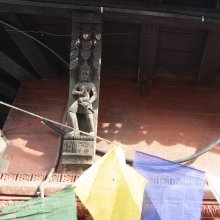Calendra, Cala-indra: 1 definition
Introduction:
Calendra means something in Buddhism, Pali. If you want to know the exact meaning, history, etymology or English translation of this term then check out the descriptions on this page. Add your comment or reference to a book if you want to contribute to this summary article.
Alternative spellings of this word include Chalendra.
Images (photo gallery)
In Buddhism
Tibetan Buddhism (Vajrayana or tantric Buddhism)
Source: archive.org: The Indian Buddhist IconographyCalendra (चलेन्द्र) refers to eight Yakṣa kings, commonly depicted in Buddhist Iconography, and mentioned in the 11th-century Niṣpannayogāvalī of Mahāpaṇḍita Abhayākara.—The Yakṣas are a semi-mythical class of beings who are supposed to preside over treasures and shower wealth on mankind when propitiated. They are all collectively described in the dharmadhātuvāgīśvara-maṇḍala in one brief sentence:—“The Yakṣa kings [viz., Calendra] hold in their hands the bījapūra (citron) and the nakula (mongoose) in the right and left hands respectively”.—Calendra is yellow in colour.

Tibetan Buddhism includes schools such as Nyingma, Kadampa, Kagyu and Gelug. Their primary canon of literature is divided in two broad categories: The Kangyur, which consists of Buddha’s words, and the Tengyur, which includes commentaries from various sources. Esotericism and tantra techniques (vajrayāna) are collected indepently.
See also (Relevant definitions)
Ends with: Acalendra, Himacalendra.
Full-text: Yaksha.
Relevant text
No search results for Calendra, Cala-indra; (plurals include: Calendras, indras) in any book or story.

